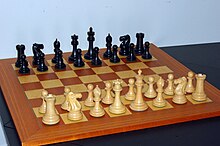
Back أبيض وأسود (شطرنج) Arabic Blanques i negres en escacs Catalan Bílý a černý v šachu Czech Hvid og sort i skak Danish Blancs et Noirs aux échecs French Dubh agus Bán i gcomórtais fichille Irish Wit en zwart in het schaken Dutch Vit och svart i schack Swedish

In chess, the player who moves first is called White and the player who moves second is called Black. Their pieces are the white pieces and the black pieces. The pieces are often not literally white and black, but usually contrasting light and dark colors. The 64 squares of the chessboard, which is colored in a checkered pattern, are likewise the "white squares" or "light squares", and "black squares" or "dark squares"; they are usually of contrasting light and dark color rather than literally white and black. For example, the squares on vinyl boards may be off-white ("buff") and green, while those on wood boards are often light brown and dark brown.[1]
white: 1. There are 16 light-colored pieces and 32 squares called white. 2. When capitalized, the word refers to the player of the white pieces.
An entry in the Glossary of terms in the Laws of Chess at the end of the current FIDE laws[2] appears for black, too.
In old chess writings, the sides are often called Red and Black, because those were the two colors of ink then commonly available when hand-drawing or printing chess position diagrams.
- ^ FIDE regulations, C. 02. 3. 1, Chess Boards – material and colour
- ^ "FIDE Laws of Chess", rules.fide.com, 1 January 2018.
© MMXXIII Rich X Search. We shall prevail. All rights reserved. Rich X Search